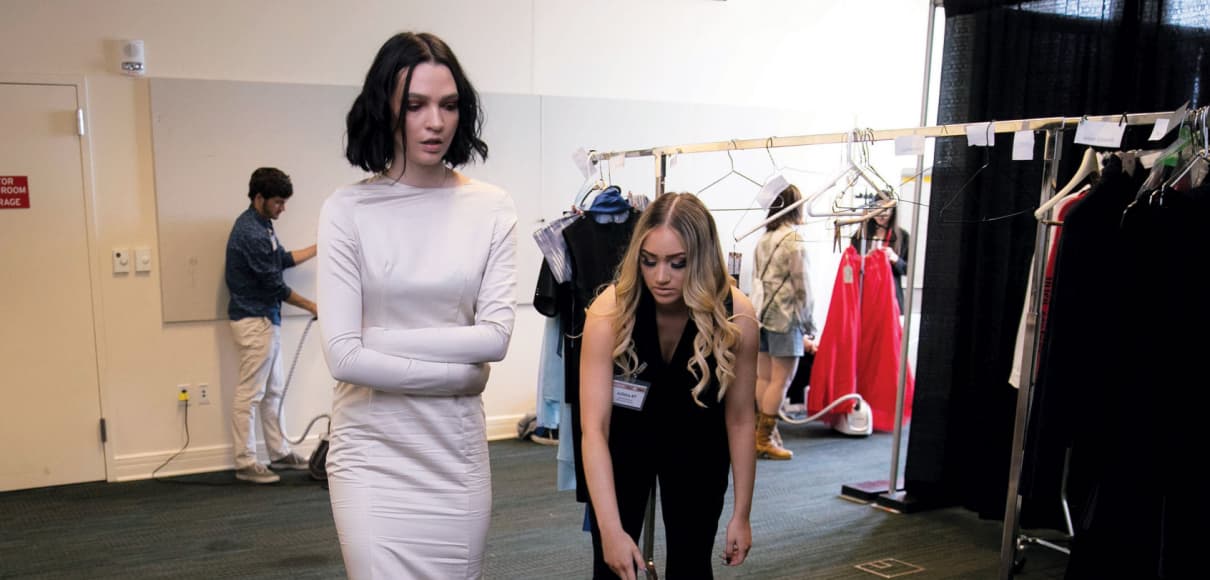Senior apparel design major Julieta Cueva was filled with trepidation over pitching her look to the three women potentially modeling her designs for the 2019 MODE fashion show. She needed them to understand the impetus for her fashion.
Cueva’s designs included a strait-jacket inspired dress, a kimono-like jumpsuit, and a bandage dress. The makeup included grungy bleached eyebrows. Her worry was that the avant-garde nature of her designs would be off-putting to them, but Cueva’s goal was to use her designs as a metaphor for the emotions people experience when they are struggling with depression or other mental health issues.
For example, Cueva used the voluminous folds of an oversized kimono that overwhelmed a model to symbolize the feeling of drowning in one’s own emotions.
Cueva’s designs were informed and inspired by research she did at Western State Hospital in Washington. Her costumes depicted the stigma, oppression, and the heavy burden of emotions people with mental illnesses face, and Cueva hoped her designs might help an audience consider and understand some of those struggles through her fashion.
“Obviously, you want people to react positively to your stuff, but that’s not always going to be the case.”
—Julieta Cueva
To her pleasant surprise, the women enthusiastically agreed to model her designs.
“I gave them a quick overview of what the collection was and what the inspiration was. One of them started researching all this stuff and was so excited,” Cueva said.
For students like Cueva who participated — models, makeup artists, designers, and stylists — the MODE fashion show offered a window into the fashion industry. At the same time, it was a creative outlet for budding designers and stylists.

The show was exciting, but it was also nerve-wracking to display fashion creations to a public audience, Cueva said.
“It’s personal, and I don’t know how other people are going to react,” Cueva said. “Obviously, you want people to react positively to your stuff, but that’s not always going to be the case.”
This was Cueva’s first time presenting her work in a public forum, and she was unsure of how her design would be received.
In the end, though, Cueva’s risk paid off. Her interpretation of mental health and depression won “Most Innovative Design” at the show.
Other awards included most marketable, best representation of Seattle, most creative, and best representation of brand.
“It offers exposure to the industry, but the best thing about this is that it builds character and your ability to follow through on ideas and make them come to life,” said Sarah Mosher, who was an advisor of MODE and professor of apparel design and merchandising at SPU last year. “In the academic setting we’re always just a little bit shy of that. The MODE fashion show is a place where they can actually action something.”

The event looked significantly different from past years. Previously, models strolled down a catwalk in Royal Brougham Pavilion. This year, the event moved to the Museum of History and Industry which prompted the group to rethink the presentation style since the new venue did not work well for a runway.
Nina Selset, the president of MODE, described it as a “science fair,” where designers and stylists would be on the floor alongside their mood boards and models.
“If we are created in the image of the Creator, then the act of creating is our highest calling.”
—Sarah Mosher
Morgan Gaston, the treasurer of MODE, said the club’s choice to switch styles also reflected the fashion industry’s move away from runway-style shows. Gaston explained that while catwalks are definitely still in use, the newer presentation style offers more opportunity for designers and stylists to explain the inspiration for their looks. It made the MODE show a more intimate experience than it had been in the past.
“I’m glad we did the presentation style because I got more comfortable speaking about designs to people that I don’t know,” Cueva said. “The enthusiasm from people helped a lot and made me less self-conscious about explaining the collection.”
Amongst other things, MOHAI became a support for MODE as they put together the show.

“MOHAI took us on as content collaborators, which meant that they really gave us creative reign, but they also completely hosted the event,” Mosher said. “We were incredibly fortunate to have that opportunity.”
MOHAI set a high bar, asking that all participating design students create a mood board (a collage of images that set a tone for their designs) and that the designs be held to professional standards. For their part, MOHAI set the theme for the event and managed the organization of the judge’s folders.
According to Mosher and Cueva, these high standards pushed the designers to be more ambitious in the creativity and quality of their designs.
The MODE fashion show was a character-building experience and provided a creative outlet for student designers. And the hands-on learning experience allowed the students to learn about themselves and about the world in a unique way. They also had the opportunity to participate in something that goes beyond a fashion show: the sacred act of creating something.
“If we are created in the image of the Creator then the act of creating is our highest calling,” Mosher asked. “Shouldn’t we be leaders in that?”






















